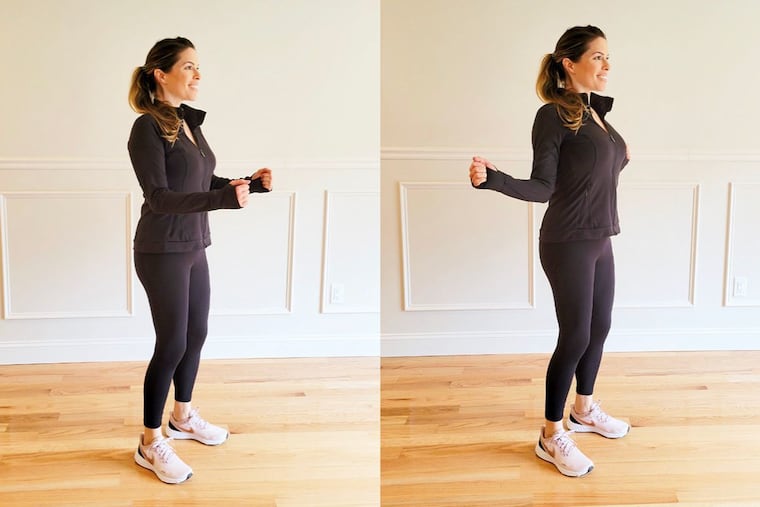5 exercises to help you stand taller and walk stronger
You only need 15 to 20 minutes, three days a week to complete these gait and posture powering exercises.

Being told you don’t look your age is often a welcomed compliment. After all, looking and feeling younger is something we are willing to invest big bucks in with procedures smoothing crow’s feet, erasing smile lines, or preserving our original hair color.
But one major aspect of achieving a youthful appearance that’s often overlooked is how you carry yourself. Nothing gives away your age quite like being hunched over or unsteady on your feet.
If you want to shave years off your image while also improving how you feel, start by taking the steps necessary to strengthen your stance and stride. Most mobility and postural issues can be remedied through exercises that boost the lower body and core, which are responsible for gait velocity and walking posture.
As the body matures, it naturally loses muscle mass and bone density. It’s for this reason that it is essential to make exercise a priority to ensure good health and a better quality of life. You need only 15 to 20 minutes, three days a week to complete these gait and posture powering exercises:
Lateral Leg Lift. When referring to posture, we usually think of the back, not the hips. But since the hips are major weight-bearing joints, your entire body depends on this area to be strong and sturdy for safety and support. To have healthy hips, you must bolster the surrounding glute and abductor muscles, as well as the hip flexors. This prevents gait deviations, promotes better posture, and enables a greater range of motion for the leg rotation.
On a well-cushioned mat, lie on your side with your head resting on the inside of your arm. Let your top arm come in front of your body so your hand is flat on the ground.
Keep your ankles flexed. Brace your core as you slowly lift your top leg, keeping it as straight as possible. Gently return your leg back down. Perform 10 reps then switch sides.
Chair Stand. While it may seem basic, shifting from a seated position to standing is one of the most effective exercises for strengthening the muscles responsible for walking and balancing. Bracing as you stand also builds better core strength which helps stabilize the spine and hips.
Push the back of sturdy chair against a wall for support. Sit so your legs are parallel and feet are forward-facing. Extend your arms in front of your body to prevent you from using them to help you stand.
Press your heels into the ground to engage your posterior leg muscles and protect your knees. When standing, squeeze your glute muscles. Aim for anywhere between five to 15 reps.
Calf Stretch. The calf enables walking, running, and jumping. It also dictates the pace at which you can perform these activities. A shortened, slowed step may result from weakened or atrophied calf muscles. By caring for your calves, you can improve your range of motion, provide better support for the surrounding areas such as the foot and ankle, and reduce your risk of developing conditions like Achilles tendonitis, plantar fasciitis, or shin splints.
Face a wall and stand about a foot away. Rest your palms flat against the wall at shoulder height.
Take a step back with your right foot, bend your left knee, and try to lower your right heel toward the floor. Do not push past your point of comfort. It should feel like a deep stretch, but not painful. Avoid allowing your front knee to extend past your toes. Hold for 10 seconds then release and practice on the opposite leg.
Single Leg March. The body is a kinetic chain where each part relies on the others to form a cohesive unit. Just as the calves support the lower body, so do the ankles. Strong ankles keep the body grounded, balanced, and reduces injuries. Ankle power is necessary for performing activities like walking, running and dancing.
Act as if you are walking in a straight line. Only, with each step you will elevate your leg.
Take a natural step forward with your right foot. Then lift your left leg foot in front of you to calf height, or if feeling especially balanced, to knee height. Hold for two counts then lower and take a step forward with your left foot and lift your right leg. Continue walking for 10 counts. Try to avoid looking down at your feet so you don’t hunch over.
Scapula Squeeze. Remember when your mom would remind you to stand up straight? Whether writing at a desk, staring at a computer screen, or holding a child, we tend to slouch. And throughout the years, this seemingly innocent habit becomes our permanent posture. When your body weight leans forward, your center of gravity shifts, which can jeopardize your balance. This problematic position also places unnecessary pressure on the neck and back.
By performing exercises that squeeze the shoulder blades (scapula) together, you can strengthen the back muscles necessary for good posture.
From standing position, bend your arms so your elbows rest at your ribs.
Keep your arms in this position as you pull your elbows back. Your chest should puff out. Hold and squeeze your shoulder blades together for five seconds. Release and repeat five times.
Ashley Blake Greenblatt is a certified personal trainer and wellness coach in South Jersey. To learn more about her virtual training program, go to ashleyblakefitness.com.